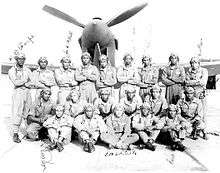Alabama World War II Army Airfields
Alabama World War II Army Airfields | |
|---|---|
| Part of World War II | |
 Map Of Major Alabama World War II Army Airfields | |
| Type | Army Airfields |
| Site history | |
| Built | 1940-1944 |
| In use | 1940-Present |

During World War II, the United States Army Air Forces (USAAF) established numerous airfields in Alabama for antisubmarine defense in the Gulf of Mexico and for training pilots and aircrews of AAF fighters and bombers.
Most of these airfields were under the command of Third Air Force or the Army Air Forces Training Command (AAFTC) (A predecessor of the current-day United States Air Force Air Education and Training Command). However the other USAAF support commands (Air Technical Service Command (ATSC); Air Transport Command (ATC) or Troop Carrier Command) commanded a significant number of airfields in a support roles.
It is still possible to find remnants of these wartime airfields. Many were converted into municipal airports, some were returned to agriculture and several were retained as United States Air Force installations and were front-line bases during the Cold War. Hundreds of the temporary buildings that were used survive today, and are being used for other purposes.
Major Airfields
Third Air Force
- Demopolis Army Airfield, 8 miles (13 km) west-southwest of Demopolis
- Detachment, 39th Base Headquarters and Air Base Squadron
- Auxiliary of Key Field, Mississippi
- Now: Demopolis Municipal Airport (ICAO: KDYA, FAA LID: DYA, formerly 7A2)
AAF Training Command
AAF Eastern Flying Training Command
- Courtland Army Airfield, 1-mile (1.6 km) southwest of Courtland
- Army Air Forces Basic Flying School/Army Air Forces Pilot School (Basic)/Army Air Forces Pilot School (Special, 4-Engine), 14 December 1942-30 June 1945
- 446th Base Headquarters and Air Base Squadron 19 December 1942-30 April 1944
- 2115th Army Air Force Base Unit 1 May 1944-1 November 1945
- Known sub-bases and auxiliaries
- Now: Courtland Airport (FAA LID: 9A4)
- Craig Field, 5 miles (8.0 km) southeast of Selma
- Air Corps Advanced Flying School (Single Engine)/Army Air Forces Advanced Flying School (Single Engine)/Army Air Forces Pilot School (Advanced, Single Engine) 16 December 1940-15 December 1945
- 57th Air Base Squadron/57th Base Headquarters and Air Base Squadron 16 December 1940-30 April 1944
- 2138th Army Air Force Base Unit (Pilot School, Advanced, Single Engine) 1 May 1944-15 December 1945
- Free French Air Force pilot training
- Known sub-bases and auxiliaries
- Later: Craig Air Force Base (1947-1977)
- Now: Craig Field Airport (IATA: SEM, ICAO: KSEM, FAA LID: SEM)
- Gunter Field, 2 miles (3.2 km) northeast of Montgomery
- Air Corps Basic Flying School/Army Air Forces Basic Flying School/ Army Air Forces Pilot School (Basic), 8 August 1940-10 September 1945
- 58th Air Base Squadron/58th Base Headquarters and Air Base Squadron, 3 October 1940-30 April 1944
- 2131st Army Air Forces Base Unit (Pilot School, Basic) 1 May 1944-13 December 1945
- Known sub-bases and auxiliaries
- Now:
 Gunter Annex (Non-flying USAF facility)
Gunter Annex (Non-flying USAF facility)
- Maxwell Field, 2 miles (3.2 km) west of Montgomery
- Air Corps Tactical School, 15 July 1931-13 May 1942
- Hq, Southeast Air Corps Training Center/Hq, Southeast Army Air Forces Training Center/Hq, Army Air Forces Eastern Flying Training Command, 1 September 1940-1 June 1946
- Air Corps Replacement Center (Pilot)/Air Corps Replacement Training Center (Aircrew)/Army Air Forces Pre-flight School (Pilot), 21 February 1941-1 December 1944
- 14th Air Base Squadron/14th Base Headquarters and Air Base Squadron, 1 September 1940-30 April 1944
- 2132nd Army Air Forces Base Unit, 1 May 1944-15 December 1945
- Headquarters, Air University
- Known sub-bases and auxiliaries
- Now:
 Maxwell Air Force Base (IATA: MXF, ICAO: KMXF, FAA LID: MXF)
Maxwell Air Force Base (IATA: MXF, ICAO: KMXF, FAA LID: MXF)
- Napier Field, 7 miles (11 km) northwest of Dothan
- Air Corps Advanced Flying School (Single Engine)/Army Air Forces Advanced Flying School (Single Engine)/Army Air Forces Pilot School (Advanced, Single Engine), 30 November 1941-19 October 1945
- 73d Air Base Squadron/73rd Base Headquarters and Air Base Squadron, 30 November 1941-30 April 1944
- 2116th Army Air Forces Base Unit (Pilot School, Advanced, Single Engine), 1 May 1944-January 1946
- Known sub-bases and auxiliaries
- Ozark Army Air Field
- Now:
 Cairns Army Airfield
Cairns Army Airfield
- Now:
- Wiksburg Auxiliary Field
- Dothan Auxiliary Field
- Headland Auxiliary Field
- Goldberg Auxiliary Field
- Hyman Auxiliary Field
- Ozark Army Air Field
- Now: Dothan Regional Airport (IATA: DHN, ICAO: KDHN, FAA LID: DHN)
- Tuskegee Army Air Field, 7 miles (11 km) northwest of Tuskegee
- Army Air Forces Flying School (Basic-Advanced)/Army Air Forces Pilot School (Basic-Advanced), July 1942-14 April 1946
- Base Detachment/318th Air Base Squadron/318 Base Headquarters and Air Base Squadron, 10 November 1941-30 April 1944
- 2143rd Army Air Forces Base Unit (Pilot School, Basic-Advanced), 1 May 1944-14 April 1946
- Known sub-bases and auxiliaries
- Griel Auxiliary Field
- Shorter Auxiliary Field
- Note: See Moton Field for Tuskegee Airmen National Historic Site
- Now: Sharpe Field (IATA: TGE, FAA LID: AL73)
Contract Flying Schools
- Bates Field, 10 miles (16 km) west of Mobile
- Contract Pilot School, Glider, 6 July 1942-15 February 1943
- 533rd Base Headquarters and Air Base Squadron, 25 May 1943-1 April 1944
- 4120th Army Air Forces Base Unit, 1 April 1944-2 April 1945
- Under Contact to: Waterman Airlines
- Known sub-bases and auxiliaries
- Later: Sub-Base of Brookley Field (ATC)
- Now: Mobile Regional Airport (IATA: MOB, ICAO: KMOB, FAA LID: MOB) and
-
 Coast Guard Aviation Training Center Mobile
Coast Guard Aviation Training Center Mobile
- Decatur Field, 3 miles (4.8 km) northwest of Decatur
- Operated by 65th AAF Flying Training Detachment (Primary)
- Under Contact to: Southern Airways
- Known sub-bases and auxiliaries
- Harris Station Auxiliary Field
- Anderson Auxiliary Field
- Beaver Dam Auxiliary Field
- Poole Auxiliary Field
- Tanner Auxiliary Field
- Now: Pryor Field Regional Airport (IATA: DCU, ICAO: KDCU, FAA LID: DCU)
- Roberts Field Airport, 4 miles (6.4 km) west of Birmingham
- Contract Glider Training
- Later: Auxiliary of Birmingham Army Air Field (ATC)
- Now: Industrial site 33°31′05″N 086°52′23″W / 33.51806°N 86.87306°W
- Hargrove Van de Graaft Airport, 3 miles (4.8 km) northwest of Tuscaloosa
- Operated by 51st AAF Flying Training Detachment (Primary)
- Under Contract to: Alabama Institute of Aeronautics
- Known sub-bases and auxiliaries
- Albright Auxiliary Field
- Foster Auxiliary Field
- Knauer Auxiliary Field
- Moody Auxiliary Field
- Rice Auxiliary Field
- Now: Tuscaloosa Regional Airport (IATA: TCL, ICAO: KTCL, FAA LID: TCL)
- Moton Field, 4 miles (6.4 km) northwest of Tuskegee
- Operated by 66th AAF Flying Training Detachment (Primary)
- Under contract to Tuskegee Institute
- Known sub-bases and Auxiliaries
- Calabee Flight Strip
- Hardaway Auxiliary Field
- Kennedy Auxiliary Field
- Now: Tuskegee Airmen National Historic Site
- Now: Moton Field Municipal Airport (FAA LID: 06A)
Air Technical Service Command
|
|
Minor Airfields
|
|
References
![]() This article incorporates public domain material from the Air Force Historical Research Agency website http://www.afhra.af.mil/.
This article incorporates public domain material from the Air Force Historical Research Agency website http://www.afhra.af.mil/.
- Maurer, Maurer (1983). Air Force Combat Units Of World War II. Maxwell AFB, Alabama: Office of Air Force History. ISBN 0-89201-092-4.
- Ravenstein, Charles A. (1984). Air Force Combat Wings Lineage and Honors Histories 1947-1977. Maxwell AFB, Alabama: Office of Air Force History. ISBN 0-912799-12-9.
- Thole, Lou (1999), Forgotten Fields of America : World War II Bases and Training, Then and Now - Vol. 2. Pictorial Histories Pub . ISBN 1-57510-051-7
- Military Airfields in World War II - Alabama

.svg.png)
